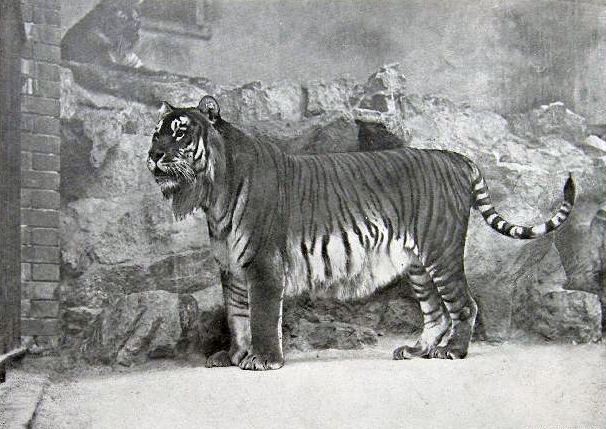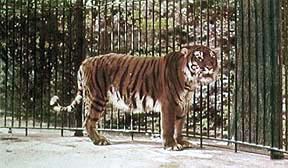Higher classification Tiger | Phylum Chordata Scientific name Panthera tigris virgata Rank Subspecies | |
 | ||
Similar | ||
Caspian tiger extinction timeline
The Caspian tiger (Panthera tigris virgata) is an extinct tiger subspecies that had been recorded in the wild before the end of the 20th century. It formerly inhabited the sparse forest habitats and riverine corridors west and south of the Caspian Sea, from Turkey, Iran east through Central Asia into the Takla Makan desert of Xinjiang, China. Its diet probably consisted of mainly wild pigs and deer, and to a lesser extent also horses. The Caspian tiger was one of the biggest cats to have ever lived.
Contents
- Caspian tiger extinction timeline
- Pelage
- Size
- Phylogenetic relationship to Siberian tiger
- Distribution and habitat
- Ecology
- Interaction with other predators
- Extirpation
- Killings or sightings
- Conservation efforts
- Restoration projects
- References
It is closely related to the Siberian tiger. It has been described as being intermediate between Siberian and Bengal tigers.

It was also called Hyrcanian tiger, Turanian tiger, Persian tiger, and Mazandaran tiger, depending on the region of origin.

Pelage

Photographs of skins of Caspian and Amur tigers indicate that the main background colour of the Caspian tiger's pelage varied and was generally brighter and more uniform than that of the Siberian tiger. The stripes were narrower, fuller and more closely set than those of tigers from Manchuria. The colour of its stripes were a mixture of brown or cinnamon shades. Pure black patterns were invariably found only on the head, neck, the middle of the back and at the tip of the tail. Angular patterns at the base of the tail were less developed than those of Far Eastern populations. The contrast between the summer and winter coats was sharp, though not to the same extent as in Far Eastern populations. The winter coat was paler, with less distinct patterns. The summer coat had a similar density and hair length to that of the Bengal tiger, though its stripes were usually narrower, longer and closer set.
Size
The Caspian tiger, together with Siberian and Bengal tigers, and the lion ranked among the largest Felidae that ever existed. The bodies of Caspian tigers were generally less massive than those of Siberian tigers (Ussuri population). Their average body length was around 3 metres (10 ft). Males weighed 170–240 kg (370–530 lb), whereas females weighed 85–135 kg (187–298 lb). The maximum known weight was greater than 240 kg (530 lb). Maximum skull length in males was 297 to 365.8 mm (11.69 to 14.40 in), while that of females was 195.7 to 255.5 mm (7.70 to 10.06 in).
Some individuals attained exceptional sizes or measurements. For example, in January 1954, a tiger was killed near the Sumbar River in Kopet-Dag whose stuffed skin was put on display in a museum in Ashgabat. Its body length was 2.25 m (7.4 ft), its skull had a condylobasal length of about 305 mm (12.0 in), and zygomatic width of 205 mm (8.1 in), its greatest skull length was 385 mm (15.2 in), which is considerably more than the other known maximum of 365.8 mm (14.40 in) for this population, and slightly exceeds those of most Siberian tigers.
In Prishibinskoye, a tiger was killed in February 1899. Measurements after skinning revealed a body length of 270 cm (8.9 ft) between the pegs, plus a 90 cm (3.0 ft) long tail, giving it a total length of about 360 cm (11.8 ft). Though males could measure up to 2.95 m (9.7 ft) between the pegs, Satunin said that it was "a tiger of immense proportions," and "no smaller than the common Tuzemna horse." It had rather long fur.
Phylogenetic relationship to Siberian tiger
At the start of the 21st century, researchers from the University of Oxford, the U.S. National Cancer Institute and the Hebrew University of Jerusalem collected tissue samples from 23 Caspian tiger specimens kept in museums across Eurasia. They sequenced at least one segment of five mitochondrial genes, and observed a low amount of variability of the mitochondrial DNA in P. t. virgata as compared to other tiger subspecies. They re-assessed the phylogenetic relationships of tiger subspecies and observed a remarkable similarity between Caspian and Siberian tiger indicating that the Amur tiger population is the genetically closest living relative of the Caspian tiger, and strongly implying a very recent common ancestry for the two groups. Based on phylogeographic analysis they suggested that the ancestor of Caspian and Amur tigers colonized Central Asia via the Gansu−Silk Road region from eastern China, less than 10,000 years ago, and subsequently traversed Siberia eastward to establish the Amur tiger in the Russian Far East. The actions of industrial age humans may have been the critical factor in the reciprocal isolation of Caspian and Amur tigers from what was likely a single contiguous population. While conducting a geographical variation study in tigers, it was discovered that the Caspian tiger is indistinguishable from other tiger subspecies. Its skull size and shape are similar to those of the Siberian tiger.
Distribution and habitat
Historical records show that the distribution of Caspian tigers in the region of the Caspian Sea was not continuous but patchy, and associated with watercourses, river basins, and lake edges. In the 19th century, they occurred:
In the Middle Ages, they may have also been present in the North Caucasus, dispersing to north of the Black Sea up to the 12th century. Heptner and Sludskii (1972) suspected that the "lyuti zver" (Old Russian for "fierce animal") that non-fatally injured Vladimir II Monomakh, Velikiy Kniaz of Kievan Rus', was a tiger. Their former distribution can be approximated by examining the distribution of ungulates in the region. Wild pigs were the numerically dominant ungulates occurring in forested habitats, along watercourses, in reed beds and in thickets of the Caspian and Aral seas. Where watercourses penetrated deep into desert areas, suitable wild pig and tiger habitat was often linear, only a few kilometers wide at most. Red and roe deer occurred in forests around the Black Sea to the western side and around the southern end of the Caspian in a narrow belt of forest cover. Roe deer occurred in forested areas south of Lake Balkash. Bactrian deer occurred in the narrow belt of forest habitat on the southern border of the Aral Sea, and southward along the Syr-Darya and Amu-Darya rivers.
Ecology
No data are available for home ranges of Caspian tigers. In search of prey, Caspian tigers were compelled to prowl widely and follow ungulates from one pasture to another. Wild pigs and cervids formed their main prey base. In many regions of Middle Asia, Bactrian deer and roe deer were important prey species apart from wild boar. Occasionally, they also preyed on Caucasian red deer, goitered gazelle in Iran, Eurasian golden jackals, jungle cats, locusts, and other small mammals in the lower Amu-Darya River area, and on saiga, wild horses, Persian onagers in Miankaleh peninsula, Turkmenian kulans, Mongolian wild asses, and mountain sheep in the Zhana-Darya and around the Aral Sea, and on Manchurian wapiti and moose in the area of Lake Baikal. They followed herds of migratory prey species such as reindeer, and caught fish in flooded areas and irrigation channels. In winter, they frequently attacked dogs and livestock straying away from herds. They preferred drinking water from rivers, and drank from lakes in seasons when water was less brackish.
Interaction with other predators
At least some of these regions were also host to other predators. In the north-east, the area of Lake Baikal was reportedly visited by the Amur tiger. In the south-west, places like northern Iraq, northern Persia and South Caucasia had Asiatic lions, Persian leopards or Asiatic cheetahs.
Extirpation
The demise of the Caspian tiger began with the Russian colonisation of Turkestan during the late 19th century. Their extirpation was caused by several factors:
Until the early 20th century, the regular Russian army was used to clear predators from forests, around settlements, and potential agricultural lands. Until World War I, about 100 tigers were killed in the forests of Amu-Darya and Piandj Rivers each year. High incentives were paid for tiger skins up to 1929. Wild pigs and deer, the prey base of the tigers, were decimated by deforestation and subsistence hunting by the increasing human population along the rivers, supported by growing agricultural developments. By 1910, cotton plants were estimated to occupy nearly one-fifth of Turkestan's arable land, with about one half located in the Fergana Valley.
Killings or sightings
In Kazakhstan, the last tiger was recorded in 1948, in the environs of the Ili River, their last known stronghold in the region of Lake Balkhash. In Turkmenistan, the last known tiger was killed in January 1954, in the valley of the Sumbar River in the Kopet-Dag Range. The last record from the lower reaches of the Amu-Darya river, near the Aral Sea, was an unconfirmed observation near Nukus in 1968. By the early 1970s, tigers disappeared from the river’s lower reaches and the Pyzandh Valley in the Turkmen-Uzbek-Afghan border region.
In the Tian Shan Range west of Ürümqi in China, tigers reportedly disappeared from the Manasi River basin in the 1960s. They disappeared from the Tarim River basin in Xinjiang in the 1920s.
In Iraq, a tiger was killed near Mosul in 1887. The last known tiger in the Caucasian region was killed in 1922 near Tbilisi, Georgia, after taking domestic livestock. In Iran's Golestān Province, one of the last known tigers was shot in 1953; one individual was sighted in the area in 1958.
There are claims of a documented killing of a tiger at Uludere, Hakkari in Turkey in 1970. Questionnaire surveys conducted in southeastern Turkey revealed one to eight tigers were killed each year in eastern Turkey until the mid-1980s, and tigers likely had survived in the region until the early 1990s. Due to lack of interest, in addition to security and safety reasons, no further field surveys were carried out in the area.
It was reported that in 1997, a tiger was killed in the northeastern region of Afghanistan.
Conservation efforts
In 1938, the first protected area Tigrovaya Balka, "tiger former river channel", was established in Tajikistan. The name was given to this zapovednik after a tiger had attacked two Russian Army officers riding horseback along a dried-up river channel called balka. Tigrovaya Balka was apparently the last stronghold of Caspian tigers in the Soviet Union, and is situated in the lower reaches of Vakhsh River between the Piandj and Kofarnihon River near the border of Afghanistan. A tiger was seen there in 1958.
After 1947, tigers were legally protected in the Union of Soviet Socialist Republics.
In Iran, Caspian tigers had been protected since 1957, with heavy fines for shooting. In the early 1970s, biologists from the Department of Environment searched several years for Caspian tigers in the uninhabited areas of Caspian forests, but did not find any evidence of their presence.
Restoration projects
Stimulated by recent findings that the Siberian tiger (Amur population) is the closest relative of the Caspian tiger, albeit slightly bigger than it, discussions started as to whether the Amur tiger could be an appropriate subspecies for reintroduction into a safe place in Central Asia. The Amu-Darya Delta was suggested as a potential site for such a project. A feasibility study was initiated to investigate if the area is suitable and if such an initiative would receive support from relevant decision makers. A viable tiger population of about 100 animals would require at least 5,000 km2 (1,900 sq mi) of large tracts of contiguous habitat with rich prey populations. Such habitat is not available at this stage and cannot be provided in the short term. The proposed region is therefore unsuitable for the reintroduction, at least at this stage.
While the restoration of the Caspian tiger has stimulated discussions, the locations for the tiger have yet to become fully involved in the planning. But through preliminary ecological surveys it has been revealed that some small populated areas of Central Asia have preserved natural habitat suitable for tigers.
